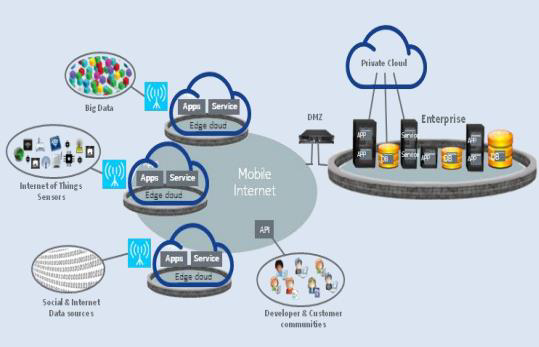MEC多接入边缘计算及关键技术
571 浏览 5 years, 8 months
5.0 Introduction
版权声明: 转载请注明出处 http://www.codingsoho.com/Edge Computing refers to a broad set of techniques designed to move computing and storage out of the remote cloud (public or private) and closer to the source of data. For the emerging class of “5G Applications” this is often a matter of necessity. Locating such applications in a traditional cloud does not allow one to meet certain stringent requirements, such as roundtrip latency. In other cases, such as the Internet of Things (IoT) and Vehicle to everything communication (V2X), the amount of data is expected to increase rapidly. Edge computing can mitigate this by collecting and processing data closer to the user.

Figure 1: Overview of the MEC system (see references [1][2])
ETSI Industry Specification Group (ISG) MEC (Multi-access Edge Computing) focuses on enabling edge computing at the access network (mobile or otherwise), thus bringing edge computing as close as possible to the user without it being in the user device. The group was established in September 2014 to standardize APIs that will enable application and content providers to utilize computing capabilities present at the edge of the network. MEC enables successful deployment of new use cases and various services that can be customized according to the customer requirements and demands. Some of key applications and use cases are:
- Video content delivery optimization
- Video stream analytics and video surveillance
- Augmented Reality and Virtual Reality (AR/VR)
- Enterprise applications enablement and local breakout
- Applications with critical communication needs such as traffic safety and control, autonomous cars, Industrial IOT and Healthcare
- Connected Cars
- IoT applications and Gateway
- Location and Context aware Services
- Smart City applications
The current prevalent distributed computing software development model uses a client-side to initiate server requests and a remote server-side to process these requests (the client-server model). This allows application developers to take advantage of centralized compute and storage and has been a major driver of the emergence of cloud computing. However, for MEC applications, developers need to identify features of their applications that require processing at the edge as distinct from features that require high compute power or that do not require near real-time response and can, therefore, be deployed at a central location. Applications have to be designed in a way which supports distributed processing, synchronization of contexts, multi-level load-balancing.
This idea is quite recent, although not totally new, and the ecosystem is quickly moving to use systems like Greengrass for Amazon’s AWS Lambda, Microsoft’s Azure IoT stack and GE’s Predix to enable it. Let’s take, for example, AWS Greengrass. This consists of the AWS Greengrass core (which is responsible for providing compute capabilities closer to the devices) and the AWS IoT devices enabled with AWS IoT Software Development Kit (SDK). Using this architecture, AWS IoT applications can in real time respond to local events and use cloud capabilities for certain functions that don’t require real time processing of data. An IoT application developer targeting AWS Greengrass has to architect the application in a way that uses these edge systems for certain features that require real time processing, or which perform some other useful tasks (e.g. limiting the data flood to the central location), while keeping other features in the traditional cloud. To provide these new services and to make the most out of MEC it is also important for the application developers and content providers to understand the main characteristics of the MEC environment and the additional services which distinguish MEC from other “edge computes”, namely: extreme user proximity, ultra-low latency, high bandwidth, real time access to radio network and context information and location awareness.
On this basis this white paper provides guidance for software developers on how to properly approach architecting and developing applications with components that will run in edge clouds, such as those compliant with ETSI’s MEC standards. The white paper will summarize the key properties of edge clouds, as distinct from a traditional cloud point-of-presence, as well as the reasons why an application developer should choose to design specifically for these. It will then provide high-level guidance on how to approach such design, including interaction with modern software development paradigms, such as micro-services -based architectures and DevOps.